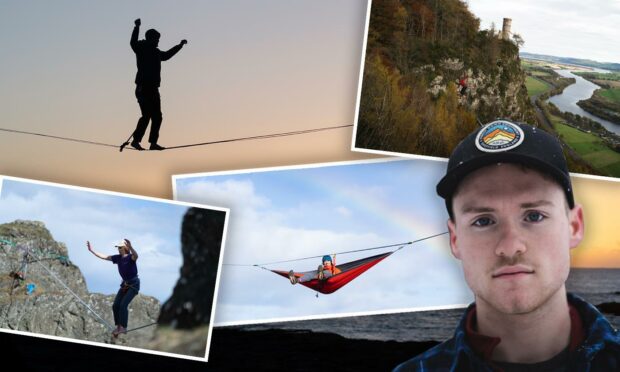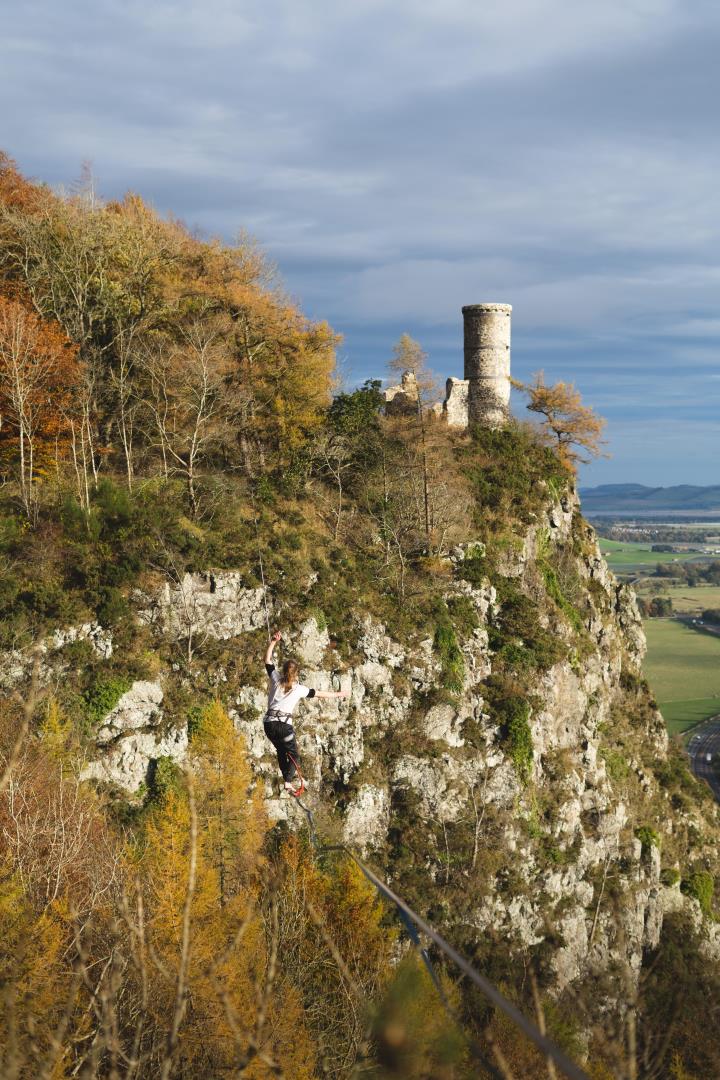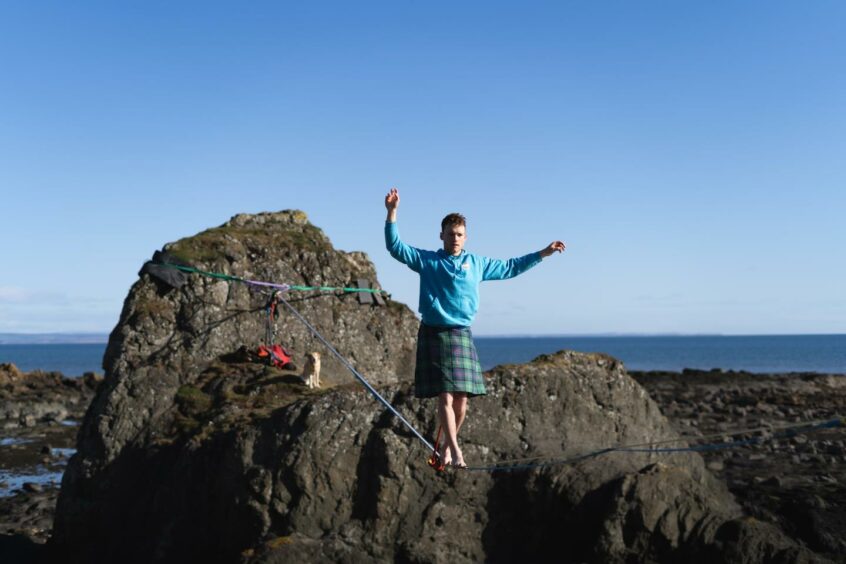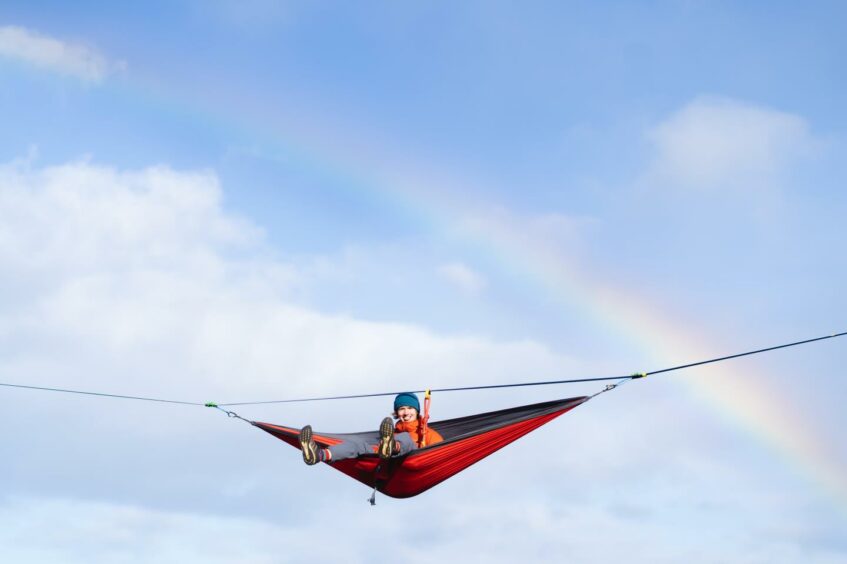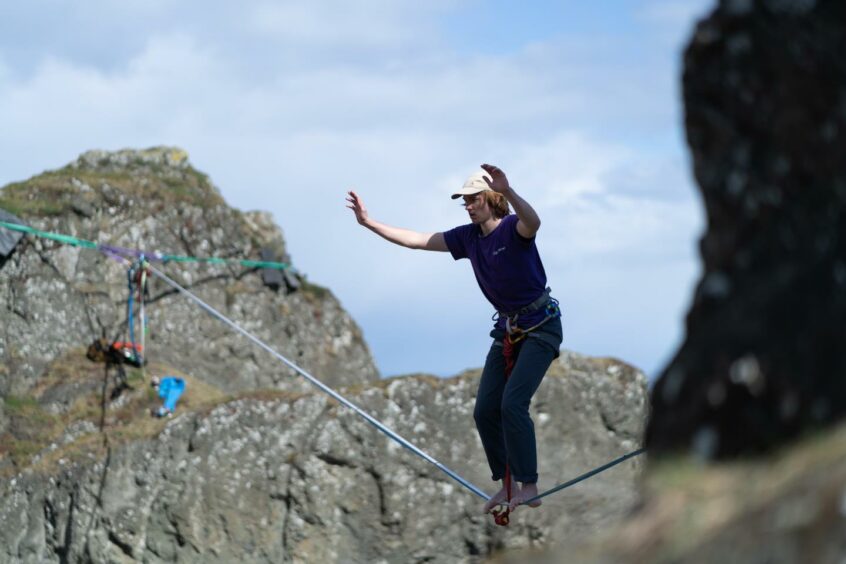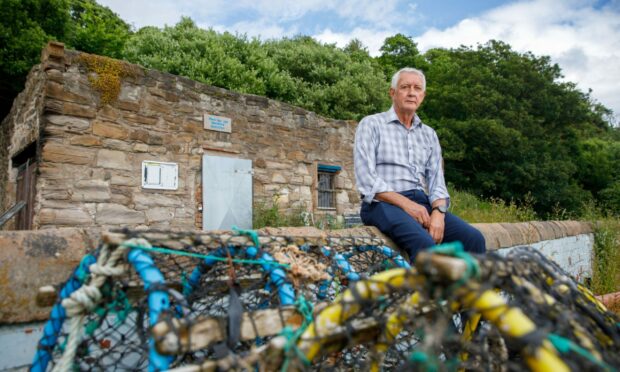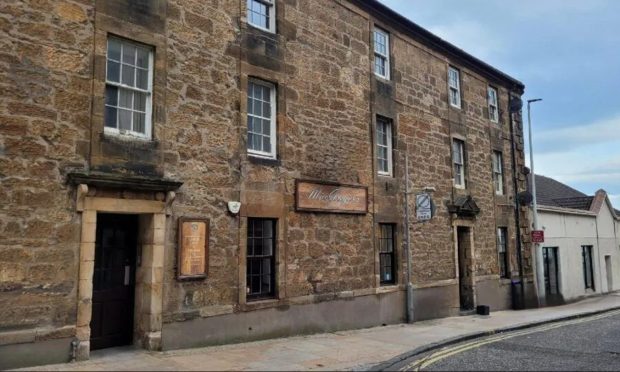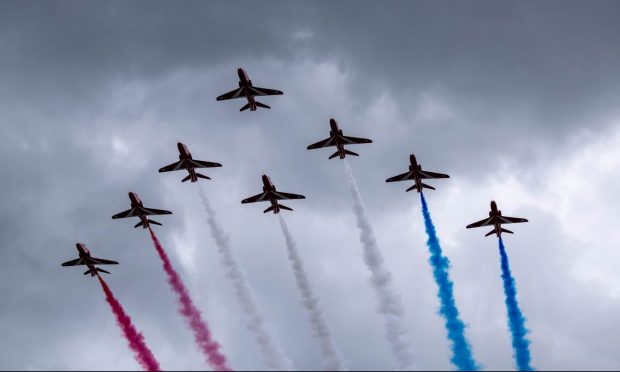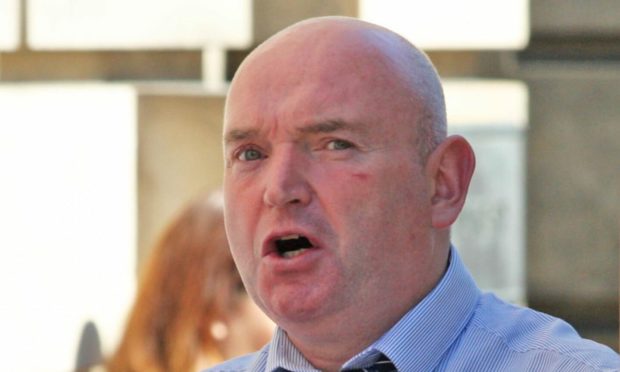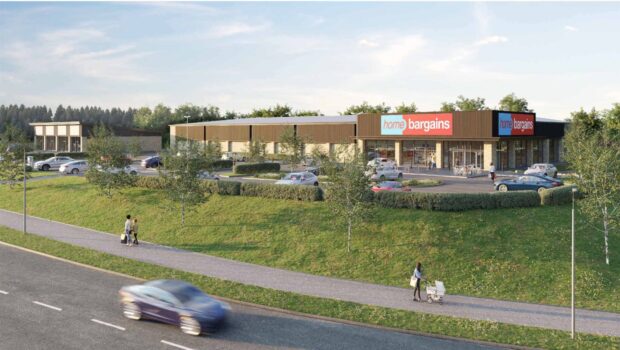A group of around a dozen young adults from the local area are stretching the boundaries of adventure by ‘highlining’ above some of Tayside’s most iconic landmarks.
Highlining is a relatively new concept in Scotland that involves tying two pieces of rope around separate trees above a big drop then walking from one side to the other.
Walkers are supported by a safety harness and rig their lines using steel rings to ensure that those who fall can bounce back up.
The skill is a variation on slacklining, which follows the same principle minus the big drop.
Owen Hope, 22, a student at St Andrews University, is one of those who has taken to highlining in 2021.
He has been in teams that have recently conquered The Hermitage, near Dunkeld, and Perth’s Kinnoull Hill, where the drop was at least 150m.
“You get such a kick out of highlining,” he says.
“It gives you a feeling that nothing else compares to.”
This feature tells the stories of local highliners where they address issues such as safety. It also includes video and images of highlining in Tayside and Fife.
‘I love life and I don’t want it to end’
Owen Hope says he is “equally as terrified of dying from the impact of falling from a height as everyone else”.
“I love life and I don’t want it to end by hitting my head against the ground,” he adds.
Owen, a fourth-year geography and social anthropology student, believes his family upbringing has helped him cope with natural fears and feels comfortable while walking along a highline hundreds of feet in the air.
He was raised in Inverness with his father Iain and mother Wendy.
“My parents are very very encouraging and open-minded,” Owen says.
“They have never told me what to do and what not to do but given carefully thought-through advice to empower me to decide things for myself.
“As a result I have not needed to rebel against anything.”
Video of Owen highlining is below
‘I am acutely aware of how dangerous it is’
Therefore, Owen says his decisions are based on a detailed risk analysis.
“Every time I am doing a highline I am acutely aware of how dangerous it is,” he says.
“There’s a risk of hurting yourself but there is no daredevil in me.
“All of my highlines are safe.”
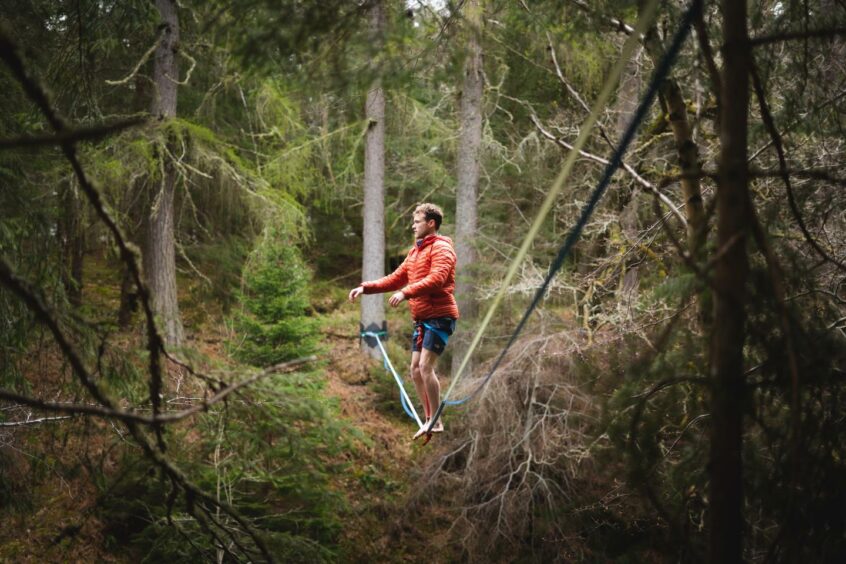
He says there is always more than one person involved in setting up a highline and ample time and effort is spent on safely designing and rigging the lines with minute attention to detail.
Owen explains that the equipment is designed to withstand shock of up to 50 kilonewtons, which is comfortably strong enough to absorb the 4kN exerted by even the largest person.
“All the gear is ridiculously strong for what we are using it for,” he says. “But it doesn’t mean we are not careful.
“My ability to be comfortable at height is related to how well we know our kit.
“We always rig things together and make decisions together.”
‘You imagine it would take lifelong training to do it’
As a youngster Owen played basketball for Scotland but his progress was hindered by Osgood-Schlatter Disease, a common cause of knee pain among adolescents.
He took up cycling and started climbing at locations including Arbroath, Dunkeld and Kirriemuir.
In December 2019 he was introduced to highlining by Michael Lehman, whose girlfriend was a St Andrews student.`
Owen watched on as he rigged what is thought to be the first highline in Fife, between the Rock and Spindle close to St Andrews.
Michael now lives in his native Australia and is still doing lots of big highline projects.
“I just thought what he was doing was impossible and that there was no way I could do the same,” Owen says. “You imagine it would take lifelong training to be able to do it.”
As it turns out, his ‘training’ lasted just a year. The lockdown restrictions of March 2020 prompted him to practice slacklining in parks in St Andrews and Dundee, where he works at the Yard Dundee adventure centre.
‘In Scotland it is hard to find someone experienced’
In March 2021 Owen joined Dundonian Johnathan Carrotte in rigging a highline at Dura Den in Kemback, near Cupar.
It was the first time either had highlined.
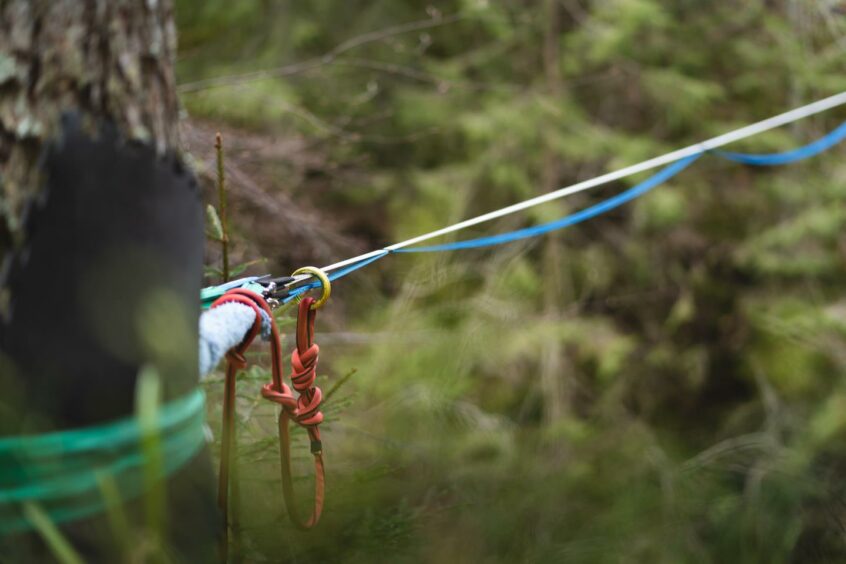
“The overwhelming advice is that you should always do it for the first time with someone experienced but in Scotland it is hard to find someone experienced,” Owen says.
“Myself and Johnathan are climbers so thought we would give it a go.
“We rigged a highline to two trees and talked about it for ages, as well as with friends.
“We went along the line and it was absolutely fine.
“It was about 30 metres long and 15 metres above the ground.”
‘No one learns to highline without falling’
On their first go both men regularly fell off the line to leave them dangling in mid-air, needing to use their strength to clamber back up.
“It’s the same as children learning to walk,” Owen says.
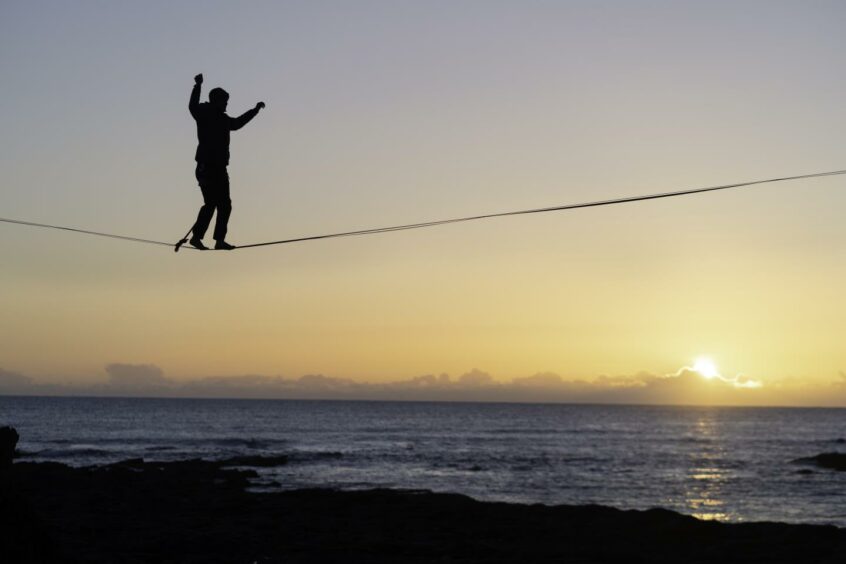
“No one learns to highline without falling. A big part of the challenge is people getting over the fear of falling.
“The reason the rigging is so strong is that we are preparing for it to happen loads of times.
“If you slackline enough the chances are you’re going to end up fit and strong enough to highline.
“You just need a good level of strength so you can climb back up.
“You might imagine well-practised experts who are flawless but we are just a bunch of students having fun doing something safe.”
‘It helps reduce the biggest risks to our health’
In 2021 Owen, always with friends, has rigged at the following places.
- Rock and Spindle (Fife)
- Kemback (Fife)
- Cawdor Gorge (Inverness-shire)
- Plodda Falls (Strathglass)
- Loch Benevean Islands (Glen Affric)
- Kinnoull Hill (Perth)
- Foyers Falls (Inverness-shire)
- Falls of Divach (Inverness-shire)
- Black Linn Falls – The Hermitage (Dunkeld)
- Dairsie (Fife)
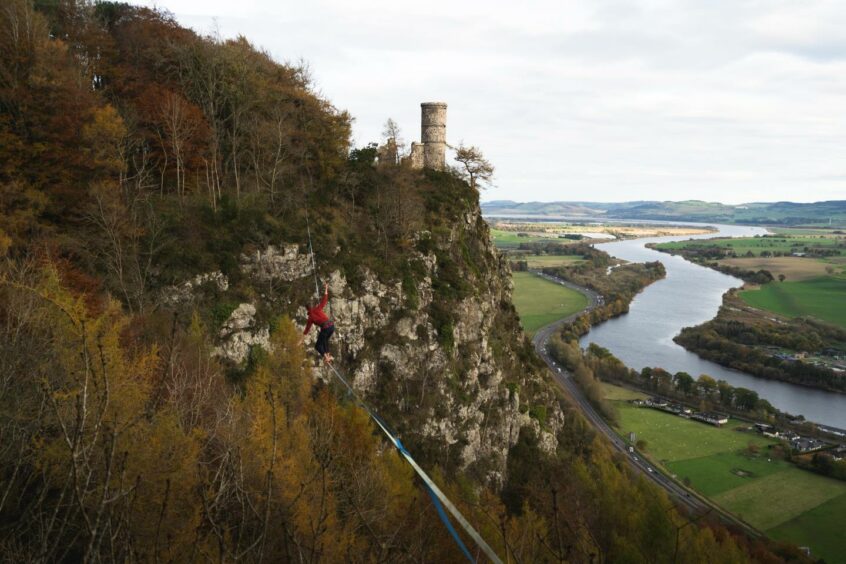
The Kinnoull Hill walk was one of the most dramatic as, taking turns with three other highliners, Owen went along a 90m-long rope at least 150m from the ground. The longest highline he has walked is 110m.
“People are going to think that it’s risky and you could die,” he says. “The biggest risks in Scotland are dying through alcoholism, drug addiction or obesity.
“So, in my eyes, what we are doing is something that makes us healthier and stronger so helps reduce the biggest risks to our health.”
Owen’s brother Neil, 23, works for MacDonald, a civil engineering contractor in Inverness, and plays high-level shinty. In his spare time he also partakes in motorbike trials.
“Society says that what he does is safe but I would argue that it is much more prone to risk than my highlining,” Owen says.
‘I have always been quite intimidated by heights’
Johnathan Carrotte says the best way to build up trust in highlining equipment is to fall from it.
The 20-year-old from Broughty Ferry says he is not a natural fan of heights but that the stringent safety measures give him confidence when highlining.
“I have always been quite intimidated by heights but overcoming this has made it worthwhile,” Johnathan says.
“We have two aluminium steel rings that go around the line and the rope goes into the harness.
“So when I fall, which can be up to seven times in a 45-minute session, you can make the bounce back up and grab the line or if you’re not confident you can climb up the rope.
“Once you have fallen you have a lot of trust in the rope.”
‘You are in a bubble of bliss’
Johnathan met Owen while studying a physics degree at St Andrews University, where he is in his third year.
He has been a member of the 25th Broughty Ferry and then 49th Dundee scout groups and is also a keen climber.
“I have always been quite active but my hobbies have allowed me to be outside without specifically doing sport.
“When you go highlining you know that you are safe but your brain knows that you shouldn’t be there.
“Then when you actually do it you are in a bubble of bliss. It’s a massive buzz when you get to the end.”
‘It does seem intimidating from the outside’
Johnathan has highlined five times and admits his parents – father Andrew and mother Rebecca – were “hesitant” when he first suggested the idea to them.
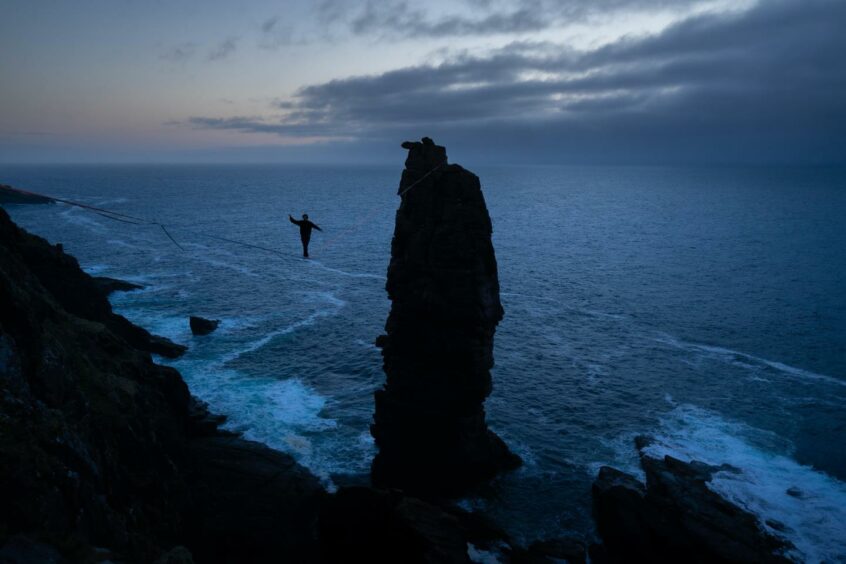
However, “they did contribute towards getting me some equipment for my birthday present,” says Johnathan, whose brother Sam, 18, is a keen mountain biker.
“They think what I do is cool but it does seem intimidating from the outside.
“My brother is a mountain biker and I am less likely to get hurt than he is.
“Highlining has made me feel more confident in myself and my ability in outdoor places.”
‘We may be the most active highliners in Scotland’
The local scene comprises of the following people who either help with rigging, walk highlines or just contribute to the group:
Alan Bruce, Alice Bocking, Amar Dhawan, Owen Hope, Johnathan Carrotte, Aidan Lynch, Mike Snap, Zack Scott, Ryan Balharry, Michael Ross, Oscar McKittrick, Alex Seal, Owain Taylor, Owen Granger, Severin Domela and Ewan Souter.
“We may be the most active highliners in Scotland right now,” Owen says. “It’s a lot of fun but there’s a lot of thought that goes behind it.”
